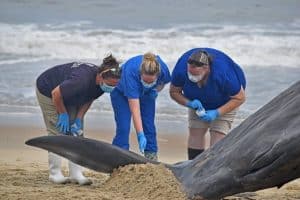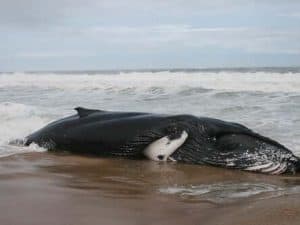
On September 15th around 6:45am, a small whale was reported stranded on the beach of Ocean City between 114th and 115th streets. The whale, a juvenile sperm whale, did not survive the stranding. Ocean City Police Department and Ocean City Beach Patrol were the first authorities on-site. The National Aquarium was designated as the lead responding agency in an event of a beached marine mammal.
Many of you commented about this tragic incident, we felt compelled to reached out to the National Aquarium for more insight about why and how this happened. Jennifer Dittmar, Director of Animal Rescue at National Aquarium, was kind enough to answers our questions after her team had such a difficult day. Below are some of your questions and the Director’s answers:
What was the name of the organization in charge of the whale rescue?
Under the current Stranding Agreement with the National Oceanic and Atmospheric Administration (NOAA), National Aquarium is designated as the lead responding agency in the event of a live cetacean stranding or sea turtle stranding in the state of Maryland. Our response is in conjunction with and under the jurisdiction of NOAA. We work with local agencies in the area where the stranding takes place.
Could you describe the process that is taken to attempt rescue?
The first step in figuring out how to help a stranded animal—whether it’s a tiny sea turtle hatchling or large humpback whale—is responding to the scene and assessing its condition. If it’s a seal or sea turtle that appears to be candidate for rehabilitation, oftentimes, the Aquarium can take the animal under its care. We work with our stranding partners throughout the mid-Atlantic region to determine where the animal can be helped.
Because of their size, it is very difficult to remove a large whale from the beach or surf and transport them. There are no facilities that can rehab a large whale and very few facilities in the U.S. that could accommodate a sick or injured dolphin, none of which are within the federally designated Greater Atlantic Region stranding network, of which the National Aquarium is part.
What kind of training/education do the rescuers have?
The National Aquarium’s Animal Rescue team consists of a full-time staff of marine biology professionals with decades of animal rescue and rehabilitation experience under their belts. They work in conjunction with the Aquarium’s Animal Health team of expert veterinarians.
What measures were administered to sustain life while rescue was happening?
When Aquarium veterinarians arrived on scene it was quickly determined the juvenile sperm whale had died. Maryland Department of Natural Resources (DNR) took the lead, in cooperation with the Town of Ocean City, in safely removing the animal from the beach.
How long does a whale of this size typically have to get back to sea before it is in danger?
Most animals that strand are already medically compromised, which further exacerbates their physical decline. When large whales are out of water, they are affected by several factors including loss of buoyancy, predation and stress. Coming in close contact with humans on the beach or in shallow water can add to their stress.
What process if any will be taken to find the cause of death?
MDNR has led a team in partnership with the National Aquarium to complete a full necropsy, an animal autopsy. We are working hard to understand what made this whale sick, if it’s a risk to other animals or people, and what, if anything, can be done to protect other animals.
Unfortunately, in situations like this it is often very difficult to determine cause of death and results may be inconclusive.
Also, it’s important to note that it may take weeks or months before we have full results from this necropsy.
The cause of death is currently unknown.
There are reports of blood from the whale on the sand, is this harmful to humans, pets, or other animals?
Pathology results from this particular whale are not completed at this time. We are working hard to understand what made this whale sick, if it’s a risk to other animals or people, and what, if anything, can be done to protect other animals.
How was the whale disposed?
The whale has been buried.
From our interview with the Director we also learned that sperm whales, amongst other species of whales, do frequent the Mid-Atlantic coast. A sperm whale stranded on the beaches of Ocean City is not common. Beyond that, sperm whales are a deep water species, this type of whale close to shore is extremely rare. The sperm whale is listed as endangered under the Endangered Species Act and depleted under the Marine Mammal Protection Act. Whales are most often seen in the Mid-Atlantic during summer months as they migrate north.

We asked these additional questions to further understand strandings, and how to best react to marine life:
Why is beaching hazardous to whales?
Stranding is a highly distressing situation for an animal, particularly a large whale or cetacean. As trained experts in the fields of animal health and animal rescue, our goal is to do everything we can to assist in providing comfort to the animal. Unfortunately, animals strand for a reason, and it’s oftentimes because something is wrong.
How and/or why do marine life get beached?
Marine animals strand for many different reasons, but most often, when a cetacean or sea turtle strands on the shoreline, it’s an indication something is wrong. The animal may have injuries caused by fishing gear, ingestion of plastic, boat strikes or oceanographic events. In other cases, the animal may be suffering from illness or disease caused by bacteria or viral infections. Seals and sea lions come on land to rest, so expert evaluation is needed to determine if they need help.
What is the survival rate of beached whales?
Because animals strand for a reason, it’s not common for whales of this size to survive. Animal advocates involved in stranding events are interested in saving individual animals whenever possible. They are also charged with ensuring that every death, as sad as that can be, helps us understand more about these amazing animals.
How can something like this be avoided? Is there education about whales that the public should know that could help to make sure this doesn’t happen again?
Unfortunately, some strandings are a natural part of the life cycle of wild animals. However, some strandings are caused by human behavior – including fishing gear, pollution, plastic intake and climate change.
What should people do if they come in close proximity to whale while at sea?
If you are on a boat or some other water vessel, it is of utmost importance to give the whale space—at least 100 yards away. When encountering marine mammals, slow down and operate at no-wake speed. Put your engine in neutral when whales approach to pass. Limit observation time to 30 minutes or less. Irresponsible behavior can disturb animals, destroy important habitats and even result in injury to animals and people.
Should the public help stranded marine animals?
In addition to being illegal, attempts by non-trained individuals to help a stranded animal may put the animal in more danger. It is also extremely dangerous for non-trained individuals to approach or touch a stranded animal. They may carry diseases, and they may bite, thrash or roll, which—given their size—can cause serious injury or death.
What should people do if they find a beached whale?
Whenever you see an animal like this in distress, the best thing you can do is give it space and immediately contact a trained wildlife first responder. NOAA’s number is 866-755-6622, NA stranding hotline is 410-576-3880 or MDNR Police 1-800-628-9944. Our teams are on call 24/7 to respond to these events.

